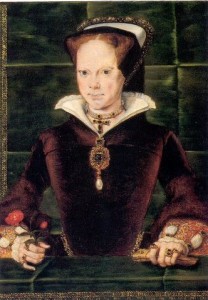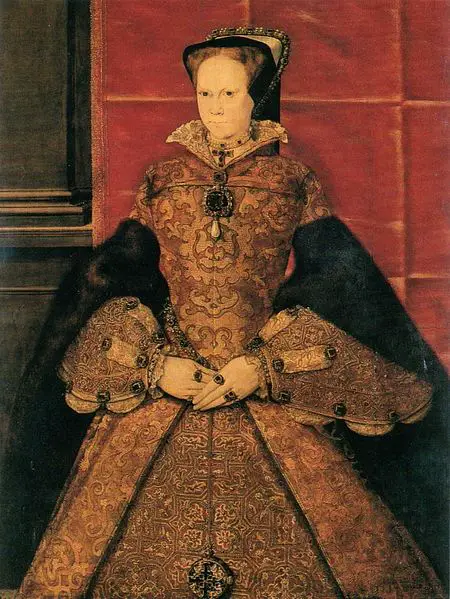On the afternoon of Saturday 30th September 1553, Queen Mary I left the Tower of London to process to Westminster, where she would spend the night at Whitehall preparing for her coronation at Westminster Abbey the following day.
Here is a primary source account of the procession from John Stow's Annals of England to 1603:
"The last of September, Queene Mary rode through the Citie of London towards Westminster, sitting in a chariot of cloth of tissue drawen by sixe horses, all trapped with the like cloth of tissue. She sate in a gowne of purple velvet furred with powdered ermine, having on her head a caule of cloth of tinsell, beset with pearle and stone, and above the same upon her head, a round circlet of gold beset so richly with precious stones, that the value thereof was inestimable, the same caule and circlet being so masste and ponderous, that she was faine to beare up her head with her hand, and the canapy was borne over her chariot. Before her rode a number of gentlemen and knights, then judges, then doctors, then bishops, then lords, then the councell: after whome followed the knights of the Bathe, thirteene in number, in their robes, the bishop of Winchester lord Chancelor, and the marquesse of Winchester lorde high treasurer, next came the duke of norffolke, and after him the Earle of Oxforde, who bare the sword before her, the maior of London in a gowne of crimosin velvet bare the scepter of gold, &c. after the Queenes chariot, sir Edward Hastings led her horse in is hand: then came an other chariot, having a covering all of cloth of silver all white, and sixe horses trapped with the like, therin sate the lady Elizabeth and the lady Anne of Cleve, then Ladies and Gentlewomen riding on horses trapped with red velvet, and their gownes and kirtles likewise of red velvet: after them followed two other chariots covered with red sattin, and the horses betrapped with the same, and certaine gentlewomen betweene every of the saide chariots riding in crimosin sattin, their horses betrapped with the same, the number of the gentlewomen so riding were 46 besides them in the chariots.
"At Fanchurch was a costly pageant made by the Genowayes: at Grace-church corner there was another pageant made by the Easterlings. At the upper ende of Grace-Streete there was another pageant made by the Florentines verie high, on the top where of there stoode foure pictures, and in the midst of them and most highest, there stoode an angell all in greene, with a trumpet in his hand, and when the trumpetter who stoode secretly in the pageant did sounde his trumpe, the angell did put his trumpe to his mouth, as though it had beene the same that had sounded, to the great marvelling of many ignorant persons: this pageant was made with three thorow fares or gates, &c. The conduit in Cornehil ran wine, and beneath the conduit a pageant made at the charges of the citie, and another at the great conduit in Cheape, and a fountaine by it running wine. The standart in Cheape newe painted, with the waites of the Citie aloft thereof playing. The crosse in Cheape new washed and burnished. One other pageant at the little conduit in Cheape next to Paules made by the Citie, where the aldermen stoode: and when the Queene came against them, the Recorder made a short proposition to her, and then the chamberlaine presented to her in the name of the maior and the city, a purse of cloth of gold, and 1000 marks of gold in it: then she rode forth, and in Paules churchyard against the schoole, one Walter Haywod sate in a pageant under a vine, and made to her an oration in Latine and English. Then was there one Peter a Dutch man stoode on the weathercocke of Paules steeple, holding a streamer in his hand of five yardes long and waving thereof, stoode sometime on the one foote, and shooke the other, and then kneeled on his knees, to the great marvell of all people. He had made two scaffoldes under him, one above the crosse, having torches and streamers set on it, and one other over the hole of the crosse, likewise set with streamers and torches, which could not burne the winde was so great: the said Peter had thirteene pound thirteene shillings and foure pence given him by the citie for his costs and paines, and all his stuffe. Then was there a pageant made against the deane of Paules gate, where the queristers of Paule plaied on vials, and long. Ludgate was newly repaired, painted, and richlie hanged, with minstrels playing and singing there: then was there an other pageant at the conduit in Fleete Streete, and the Temple barre was newly painted and hanged. And thus shee passed to White hall at Westminster, where shee toke her leave of the lord maior, giving him great thankes for his paines, and the Citie for their cost."
Simon Renard recorded in a letter to Philip of Spain:
"On the eve of her coronation-day, the Queen was removed from the Tower and castle of London to Westminster Palace, where the sovereigns of England are by custom wont to reside in London. She was accompanied by the earls, lords, gentlemen, ambassadors, and officers, all dressed in rich garments. The Queen was carried in an open litter covered with brocade. Two coaches followed her; the Lady Elizabeth and the Lady (Anne) of Cleves rode in one, some of the ladies of the Court in the other. The streets were hung with tapestries and strewn with grass and flowers; and many triumphal arches were erected along her way." Calendar of State Papers, Spain, Volume 11, 3rd October.
You can read another primary source account in The chronicle of Queen Jane, and of two years of Queen Mary, and especially of the rebellion of Sir Thomas Wyat - click here to read now, from the bottom of page 27.
See also:





I love the Tudors and the history, I have books on books on them but nothing like true history thank you so much. I would love to join but I’m on disability an can not afford to do so.